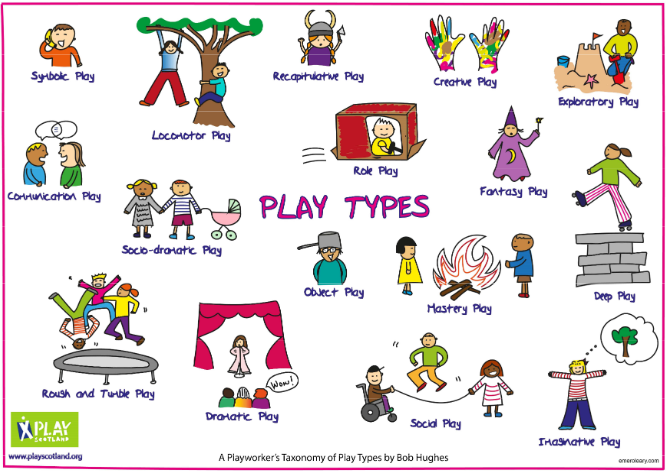Play
What is it?
“Every child has the right to relax, play and take part in a wide range of cultural and artistic activities.”
(Article 31, United Nations Convention of the Rights of the Child)
Froebel stated play was “the highest form of learning” (Bruce, 2005, p. 5), while the Scottish Government’s definition is,
“Play encompasses children’s behaviour which is freely chosen, personally directed and intrinsically motivated. It is performed for no external goal or reward and is a fundamental and integral part of healthy development… There are many forms of play, it can be “active, passive, solitary, independent, assisted, social, exploratory, education or just for fun. It can happen indoors or outdoors, it can be structured, creative, messy, entirely facilitated by the imagination or can involve using the latest gadget.”
(Play Strategy for Scotland: Our Strategy, Scottish Government, 2012, p. 12)
Bruce (2011) describes 12 features of play that we refer to as free-flow play:
-
- Children use first-hand experiences from life
- Children make up rules as they play to keep control
- Children symbolically represent as they play, making and adapting play props
- Children choose to play – they cannot be made to play
- Children rehearse their future in their role play
- Children sometimes play alone
- Children pretend when they play
- Children play with adults and other children cooperatively in pairs or groups
- Children have a personal play agenda, which may or may not be shared
- Children are deeply involved (see Leuven Scale) and difficult to distract from their deep learning as they wallow in their play and learning
- Children try out their most recently acquired skills and competencies as if celebrating what they know
- Children coordinate ideas and feelings and make sense of relationships with their families, friends and cultures
Key messages:

Multiple play types exist from Whitebread’s (2012) five types of play to Hughes’ (1996) 16 play types.
These play types overlap, and multiple play types can co-occur simultaneously, e.g. children engaging in physical play with rules and objects (Additional information on play types can be found here: Sharing the Ambition).
- Practitioners provide real and authentic, open-ended resources that promote curiosity, creativity, and achievement.
- Practitioners maximise access to outdoor spaces to enable bigger, messier and riskier outdoor play.
- Knowledgeable, engaged and passionate practitioners recognise and understand the value of play as a vehicle for learning.
- Sensitive interactions with practitioners enable children to gain the maximum potential of learning from their play.
- Skilful practitioners enhance the provision using responsive invitations and provocations to inspire children’s engagement with potential learning experiences.
Ways we can do this:
Create a high-quality environment: Settings create a clear rationale for play and share this with all stakeholders.
A successful learning environment requires careful consideration of the physical (indoor and outdoor spaces) and emotional environment to ensure play and learning can flourish. High-quality and nurturing environments support play and learning by providing a safe space that inspires children to take risks, be creative, be curious, try new things and practice new skills.
The role of the adult in supporting play and learning experiences: The adults, the experiences they create, and the interactions they engage in with the children are crucial to successfully enable a child-centred play pedagogy which includes:
- Valuing play and understanding the importance of play in a child’s development.
- Creating a warm and inviting learning environment that provides support while promoting challenge, creativity, curiosity and independence through planning for the environment, interactions and experiences indoors and out.
- Observing the child playing, deepening and extending the learning responsively and through planned future experiences (intentional planning) that meet the child’s needs.
- Documentation of the learning process is recorded in learning journeys, Floorbooks, and learning walls (making learning visible).
- Facilitating play and learning; through engaging in the play, providing resources as needed, and documenting the experiences as they occur.
- Experiences are developmentally appropriate, engaging, provoking curiosity and wonder, using real-life and open-ended resources, and supporting the child’s holistic development.
- Quality experiences are provided within the environment based on the children’s interests. The use of high-quality continuous provision will enable all children to access playful learning opportunities at their own stage of development.
- Practitioners understand when to wait, watch, wonder and when to support, deepen and extend the activity or learning.
(Information taken from: Realising the Ambition, Education Scotland, 2020)
Linked Areas of Practice
Block Play
Children’s Rights
Child’s Voice
Creativity
Learning Environment
Loose Parts
Play Pedagogy
Risky Play
Sensitive Interactions
Spaces
Sustained Shared Thinking
Tools
Reflecting on Practice
SBC Guidance to support
National Guidance to support
Further Reading to support
Training to support
